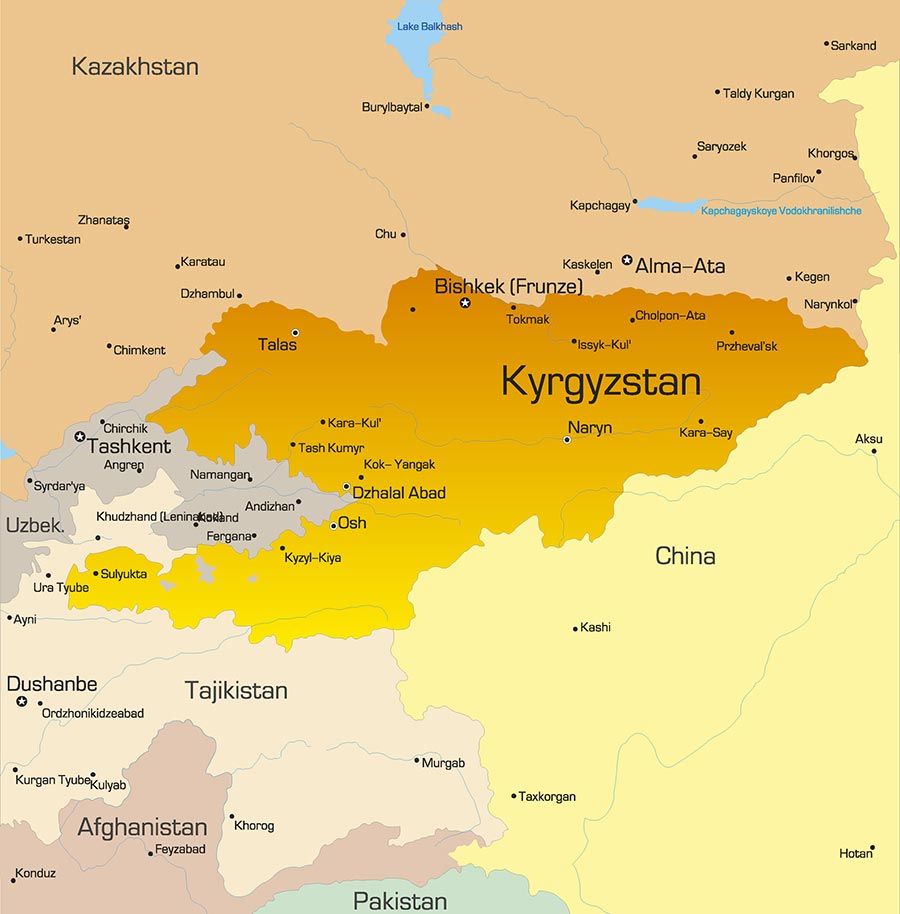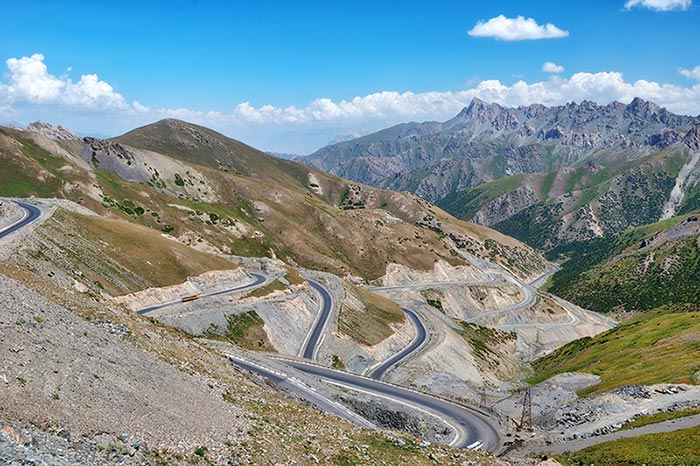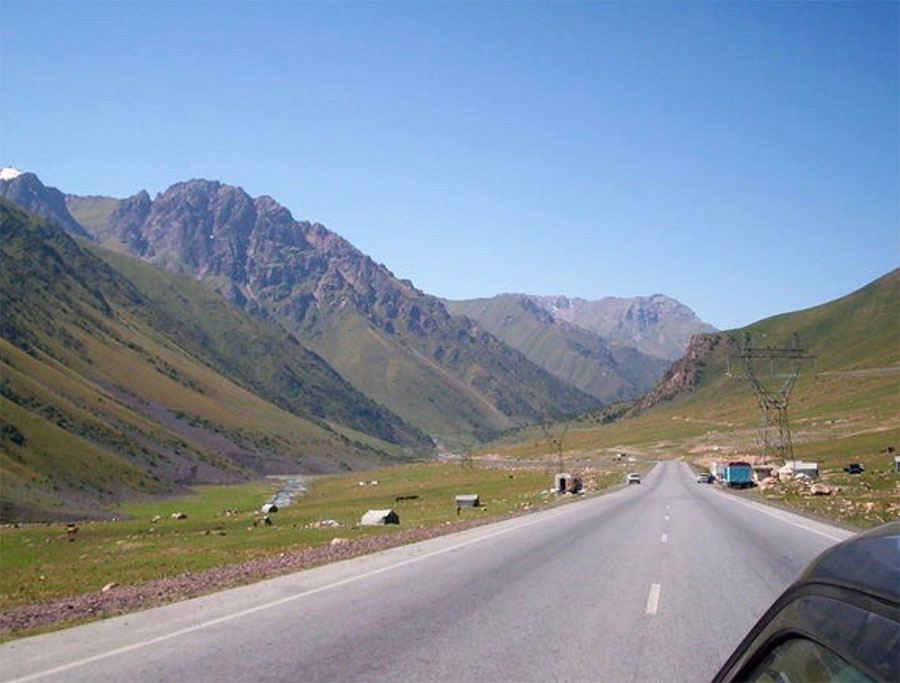Kyrgyzstan And The Belt & Road Initiative: Trans Central Asian Road & Rail Connectivity & Added Value Manufacturing Services

Op/Ed by Chris Devonshire-Ellis
Kyrgyzstan is another Central Asian country with a sizeable border with China’s Xinjiang Province, some 1,063 km in length from the tripoint with Kazakhstan, following a roughly south-west line across various mountain ridges and peaks of the Tian Shan mountain range to the border with Tajikistan.
Although the southern part of the border close to Tajikistan is dominated by the high-altitude almost impassable and dangerous mountains, the topography levels off somewhat to the north, meaning the potential for more advanced connectivity via road and rail is possible as opposed to the difficult terrain across to Tajikistan and its China border, which is only passable 12 weeks of the year between May and November.
This has made the border crossing between China and Kyrgyzstan something of a bottleneck as it is used to ferry goods on a pan-Central Asian basis, not just to Kyrgyzstan but also t Tajikistan and further West to Uzbekistan. Consequently, the crossing at Erkeshtam, at an elevation of just under 3km above sea level, gets highly congested. This route, which connects China’s G3013 road to Kashgar and the Krygyz A372 highway leading to the main trading hub of Osh, also carries a twice weekly bus service across the border.
This site, despite the difficult terrain, is also the site of one of China’s main dream Belt and Road projects: the development of a railway line heading West over the Kyrgyz Tan Shan, to Osh and along the Ferghana Valley through to Uzbekistan and to link up with connections there through to Iran and the International North-South Transportation Corridor (INSTC). Such a line would provide the first trans-Central Asan railway from East to West and would also link up with Central Asian lines heading North-South, the proposed Trans-Afghan route from Uzbekistan south to Pakistan and the Arabic Sea Ports at Gwadar and Karachi, as well as spurs leading into Tajikistan, which I discussed in this article. Should this happen, then Central Asia would be bisected to the four corners of the world for the first time and have seaport access – important for counties like Kyrgyzstan that are completely landlocked.

There have been regional difficulties to overcome. Following the demise of the Soviet Union, factional fighting broke out between Central Asian states over long held – and previously suppressed – land and border disputes. These have rumbled on, but China has been playing the diplomat – mindful that it will never get a connecting rail route or be able to better unite Central Asia, it has been brokered peace and settlement deals, not least the long running territorial disputes between Kyrgyzstan and Uzbekistan, which was finally, if uneasily resolved earlier this year. China needs that route clear, stretching along the Ferghana valley to markets in Uzbekistan, itself a reform-minded nation bringing in a great number of Western styled reforms and opening that are making the country a Central Asian hot spot. European banks and investors are taking the developments in Uzbekistan very seriously: the country has just doubled its range of free traded products with the EU, is now home to retailers such as Carrefour and is offering infrastructure investment deals via PPP’s to foreign banks. It is also edging closer to a Free Trade Agreement with the Eurasian Economic Union, which would unite it with nearby free trade with Russia, Kazakhstan, and Kyrgyzstan.
But access to Uzbekistan is currently dependent on highways, and road travel. Overcoming and upgrading that to rail is the key, and this is where Kyrgyzstan holds the cards and the challenges. In fact, a commercially viable – and used – multi-modal route already exists – the China-Kyrgyzstan-Uzbekistan (CKU) railway is open for business and the first cargo, US$2.5 million worth of electrical goods – left Lanzhou in China’s Western Gansu Province to Kashgar and onto Tashkent in June last year. It’s just that from Kashgar, the goods were loaded onto trucks for the journey westward across Kyrgyzstan to the city of Osh, where they were reloaded onto a train headed for Tashkent. Part of that route used the Pap-Angren railway line in Uzbekistan that the Chinese helped build and which opened in early 2016. The total route was about 4,400 km and took seven days to complete. Building and connecting a railway in between remains the objective.

The Taldyk Pass, Kyrgyzstan
Kyrgyzstan wants the line built, and stands to benefit from transit fees, while the Government is keen to re-position the country, one of the poorest in Central Asia, as a transportation hub. It has existing experience of this, the reexport of Chinese manufactured consumer goods to Kazakhstan and Russia, centered on the Dordov Bazaar in Bishkek, and on to Uzbekistan, centered on the Kara-Suu Bazaar in Osh is particularly important; and makes up a significant part of Kyrgyzstan’s economic activity.
Kyrgyzstan’s population is just 6.5 million, making it ideal as an educated Central Asian service hub, while exports are estimated to be worth about US$2 billion, and include gold, cotton, wool, garments, meat, mercury, uranium, electricity, machinery, and footwear. It imports about US$4.5 billion worth of goods, including oil and gas, machinery and equipment, chemicals, and foodstuffs.
The traders that one sees in Beijing, Xi’an, Shanghai, and other Chinese cities selling those huge fruit cakes stuffed with almonds, dried apricots, and cherries with the occasional whiff of illicit Central Asian plum brandy are mainly of Kyrgyz origin and make up much of the trading Muslim area – along with the Uyghur locals – in the Muslim quarters of Urumqi. Sharp eyes and sharp witted, they often run circles around their Uyghur cousins, considered backwards as they press for relaxations and confrontations from and with Beijing that the Kyrgyz already know are impossible – in their day, that center was Moscow. They have adapted to the new post-Soviet autocracy and have learned how to trade without upsetting their political masters and bringing problematic results upon their communities. It is more subversive in a way, and more regionally astute, prepared to be integrated and less obvious to better effect that the Xinjiang Uyghurs are generally not. The West, in highlighting problems not of their region, confuse the Uyghurs to their ultimate detriment.
The Uyghurs should be listening to their regional neighbors for advice over improving their trade and integration circumstances, not Brussels or Washington, whose troops are fresh off the ground from fighting and killing Sunnis in Afghanistan.
There are issues that both Kyrgyzstan and its neighboring countries have needed to solve. Kyrgyzstan has not had the most stable of political situations, and local political alliances have interfered with route planning. The Chinese want to build the shortest route across the country, while two years ago, then Kyrgyz President Almazbek Atambaev proposed the railway take a different route so that trains would also serve the remote Kyrgyz towns of At-Bashi and Kazarman, a significant deviation north from the original plan and one that would add US$1.5 billion to the construction costs. He now appears to be out of the picture, imprisoned from October last year and facing charges of corruption.
The preferred Chinese route would use the Erkeshtam Mountain pass, about 230 km west from Kashgar, and the route that trucks currently use as part of the road-rail link. Kyrgyzstan’s Minister of Transport has estimated the cost at US$4.5 billion. The route is not long, running about 450-500 km, however, passes through mountains with altitudes of up to 3,500 meters. The route requires the construction of nearly 50 tunnels and more than 90 bridges. That is a huge cost burden for Kyrgyzstan.
if the route can be agreed, its usage would provide a direct rail link between China and the Middle East. Currently, that route is served by rail passing through Kazakhstan’s Khorgos, but estimates show that the Kyrgyz route would save five days from the transshipment time. That prospect might not be great news for Kazakhstan, but several other countries stand to benefit from such a route if a route can traverse Kyrgyzstan. Proposed extensions would run through Afghanistan, Iran, and Turkey to Europe, while another would run through Turkmenistan and, by ferry, across the Caspian Sea to Istanbul and to Europe.
Financing the route then becomes the issue. There are ways that China can assist. It benefits longer term as its trade through Central Asia and onto the Middle East will increase. It will win via security as well; settling down Uyghur unrest via creating wealth through trade is an on-going process. It also provides China with a third corridor West and keeps both Kazakhstan and Russia competitive. Low-interest loans are a given along BRI projects, and China can either waive or partially waive these by taking a mortgage against Kyrgyzstan’s future transit fees.
Other countries could also be persuaded to chip in – Uzbekistan for sure is supportive of the route, but it too has financial issues, not helped by the Covid-19 situation. In the meantime, Kyrgyzstan is undergoing political changes after elections in October resulted in riots after the incumbent Government won a “super-majority”. A re-run of the election held in January this year – the new incumbent President Sadyr Japarov winning 80% of the popular vote. He is regarded as a pragmatist and a populist, and as a qualified lawyer, will be feeling his way into the job. Decisions as regards the railway can be expected during his initial term. Bakyt Berdaliev, the current Kyrgyz Minister of Transport and Roads told Xinhua that the China-Kyrgyzstan-Uzbekistan railway, an important project being constructed, will become “the southern branch of the Eurasian continental bridge” and will “open access to the markets of Southeast Asia, Western Asia and the Middle East” further stating that he believes this route will ensure the delivery of goods from China to Kyrgyzstan and the Middle East countries. “More importantly, it will increase competitiveness in the international transit market.”
Creating logistics hubs in the country also needs to be carried out with more domestic political sensitivity than has occurred in the past. China cancelled a planned S$275 million logistics centre in At Bashy, after locals rioted over their loss of grazing pastures. Old traditions and ways of life die hard, and the reeducation and benefits of new technologies and employment require discussion, not just turning up and digging.
Meanwhile, the Kyrgyz economy has been among the more liberal and open among Central Asian countries. It was the first Central Asian country to become a WTO member in 1998 and its trade share in GDP is the highest in the region. This is largely due to the flourishing cross-border trade with its large markets at Dordoi and Kara-Su, transshipping large volumes of goods: importing goods through both formal and informal trade systems, mainly from China, and re-exporting (in few cases with some value-addition) to other regional economies. Tajikistan has a ready built transportation and logistics system in place that rail connectivity would super-charge. It also possesses a well-educated layer of trade professionals that caters well to this large ‘entrepot’ trade, while domestic agriculture and light manufacturing have also contributed to exports.
The onus of China’s Belt & Road investment into Kyrgyzstan, has therefore been in added value manufacturing and transit projects, with investments to date estimated to be about US$5 billion, with long term repayment schedules to allow an infrastructure ROI to develop before repayments kick in, although Covid will have extended that period somewhat. Chinese build has included the Bishkek-Naryn-Torugart highway, the Bishkek-Osh highway, while an alternative road connecting the country’s north, and south is currently under construction providing road links between Kazakhstan and Tajikistan. These are already the largest construction infrastructure projects in Kyrgyz history.

The Bishkek-Osh Highway, built by the China Road and Bridge Corporation
If Kyrgyzstan can get through fiscal tax reforms to better balance and incentivize its talents as a trans-shipment and added value Central Asian hub, then its future looks bright, while Getting those reforms into place will provide much more confidence that the much-discussed railway connectivity would happen. That will mean revisiting its strategy concerning Special Economic Zones, which to date have been badly managed and largely failed, mainly due to an overly aggressive domestic customs regime reluctant to cede local collection powers. However, China has experience in this, and the new President looks promising. Given a couple of years to work out how to deal with these problems, announcements of new tax and incentive laws, combined with a rail connectivity green light will signal that Kyrgyzstan is ready to take advantage of its regional Central Asian transshipment service center potential.
Related Reading
- Heads of State Calls For Acceleration Of Eurasian Economic Union Alignment With China
- Conquering The Mountains: Tajikistan And The Belt And Road Initiative
- Turkmenistan: Gradually Opening To The World Via Belt & Road Trade
About Us
Silk Road Briefing is written by Dezan Shira & Associates. The firm has 28 offices throughout Asia, and assists foreign investors into the region. For strategic advisory and business intelligence issues please contact the firm at silkroad@dezshira.com or visit www.dezshira.com





